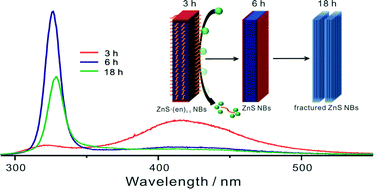A facile growth mechanism of wurtzite ZnS nanostructures showing intense ultraviolet luminescence†
Abstract
Despite recent achievements in the synthetic processes of wurtzite ZnS nanostructures via the post-thermal decomposition of ZnS·(en)0.5 (en = ethylenediamine) nanocomposites, investigation into the growth mechanism of wurtzite ZnS from ZnS·(en)0.5 is still challenging. Diverse methods such as transmission electron microscopy, X-ray diffraction, thermal gravimetric analysis, X-ray photoelectron spectroscopy, and Fourier-transform infrared spectroscopy have been employed to understand the facile growth mechanism of wurtzite ZnS nanobelts showing intense ultraviolet luminescence. Wurtzite ZnS nanobelts have been found to form as en molecules escape via hydration from the lamellar structures of ZnS·(en)0.5 nanobelts, which are a reaction intermediate produced at the early stage of the reaction. The chemical composition, the morphology, and the optical properties of the produced ZnS nanobelts have been controlled well by systematically varying time, temperature, and solvents. In particular, wurtzite ZnS nanobelts of 1.0 μm in length, 80 nm in width, and 16 nm in thickness, grown optimally in a 1 : 1 : 2 volume mixture of water : en : N2H4·H2O at 180 °C for 6 h, have intense and narrow band-edge emission at room temperature, suggesting their potential applications in nano-optoelectronic devices.


 Please wait while we load your content...
Please wait while we load your content...